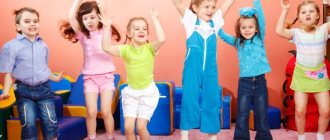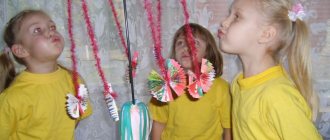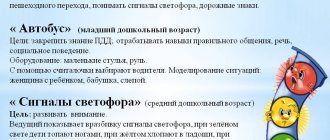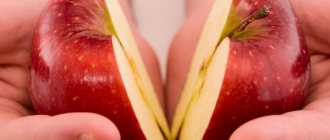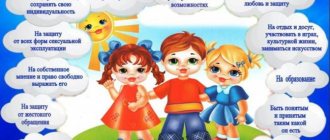Action pictures for children
Pictures depicting actions will help teachers and parents organize their children’s education correctly and at the same time in an interesting way.
Colorful drawings stimulate the child’s memory and imagination. They will invariably attract and concentrate children's attention. They will direct the learning process in the right direction.
The purpose of such activities may be:
- identifying the level of the child’s vocabulary and increasing it;
- development of coherent speech;
- constructing correct simple/complex sentences;
- teach your child to select and correctly use different parts of speech;
- compose questions yourself and specifically answer those asked by your interlocutor;
- stimulation of memory, fantasy;
- development of logical thinking;
- training of observation, taking out;
- activation of imagination;
- acquiring new social experience.
Not only pictures depicting actions, but also illustrations of objects (furniture, dishes, vegetables and fruits), plot drawings are indispensable assistants in the learning process of preschoolers.
Card index of didactic games on the topic “Professions” (second junior group)
Card index of didactic games
“All professions are needed, all professions are important!”
“Who works where?”
Target:
to clarify children’s ideas about where people of different professions work and what their workplace is called.
Kindergartener; school teacher; doctor - in a hospital, clinic, kindergarten, school; cook - in the kitchen, dining room, restaurant, cafe... etc.
“Who knows and can do this?”
Target:
expand children’s ideas about what knowledge and skills people of different professions should have.
Knows children's poems, tells fairy tales, plays and walks with children... a teacher.
Plays the piano, knows children's songs, teaches singing, dancing, plays musical games with children... music director.
Knows the human body, can provide first aid, knows how to recognize and treat diseases... a doctor, etc.
"Who does this?"
Target:
to train children in the ability to determine the name of a profession by the names of actions.
Cuts, styles, washes, combs, dries... hairdresser.
Soaks, soaps, washes, shakes, dries, irons... the laundress.
Packs, weighs, cuts, wraps, counts... the seller.
Cleans, washes, fries, cooks, cooks, salts, tastes, feeds... cook, etc.
"Who's doing what?"
Target:
expand and clarify children’s ideas about the work (labor operations) of people of different professions.
The janitor sweeps, cleans, waters, rakes...
The music director sings, plays, dances, teaches...
The junior teacher (nanny) washes, cleans, wipes, covers, dresses, reads... etc.
"Correct the mistake"
Target:
teach children to find and correct mistakes in the actions of people of various professions.
The cook treats, and the doctor cooks.
The janitor sells, and the seller sweeps.
The teacher cuts the hair and the hairdresser checks the notebooks.
The musical director does the laundry, and the laundress sings songs with the children... etc.
“For a person in what profession is this necessary?”
Target:
expand children’s understanding of the items necessary for a person in a certain profession.
Scales, counter, goods, cash register... - to the seller.
Broom, shovel, hose, sand, crowbar, snow blower... - to the janitor.
Washing machine, bath, soap, iron... - to the laundress.
Comb, scissors, hair dryer, shampoo, hairspray, hair clipper... - to the hairdresser, etc.
“Who needs what for work?”
Target:
expand and clarify children’s ideas about the objects of the surrounding world (materials, tools, equipment, etc.) necessary for work by people of different professions.
The teacher - a pointer, a textbook, chalk, a blackboard...
For the cook - a saucepan, a frying pan, a knife, a vegetable cutter, an electric oven...
The driver - a car, a spare tire, gasoline, tools...
Art teacher - brushes, easel, clay, paints... etc.
“Clap your hands if this is necessary for ... (name of profession)”
Target:
exercise the ability to correlate words and phrases with a certain profession of a person.
Children are invited to clap their hands when they hear a word or phrase that is suitable for a profession, for example, a doctor: haircut, cold, scales, ambulance, sewing machine, seeing patients, fashionable hairstyle, washing powder, white coat, snowblower, etc. .
“Who can name more actions?” (with a ball)
Target:
teach children to correlate the actions of people of different professions.
The teacher names a profession and, in turn, throws the ball to the children, who name what a person in this profession does.
"Continue the sentence"
Target:
practice the ability to complete sentences using words and phrases related to a person’s specific profession.
The cook cleans... (fish, vegetables, dishes...),
The laundress washes...(towels, bed linen, bathrobes...).
A teacher in the morning with children...(does exercises, has breakfast, conducts classes...)
A janitor in the yard in winter...(shovels snow, clears areas, sprinkles sand on paths...), etc.
“I start the sentence and you finish it”
Target:
consolidate children’s ideas about the meaning and results of the work of people of different professions.
If there were no teachers, then...
If there were no doctors, then...
If there were no wipers, then...
If there were no drivers, then... etc.
“Who does what”
Target:
Fix the names of actions performed by people of different professions.
Progress of the game.
Children take a picture of a person in a certain profession and say what he does. Cook... (cooks food), doctor... (heals people), teacher... (teaches children), builder... (builds houses), artist... (paints pictures), pianist... (plays the piano), writer... (writes books), dressmaker...(sews clothes), laundress...(washes clothes), cleaner...(mops floors), salesman...(sells goods), photographer...(takes photographs of people), teacher...(raises children), weaver...(weaves fabrics), machinist …(drives the train), controller…(checks tickets), typist…(types), etc.
“Who knows more professions”
Target:
Teach children to correlate the actions of people with their profession, to form corresponding verbs from nouns (builder - builds, teacher - teaches, etc.).
Progress of the game.
Educator. I work in a kindergarten as a teacher. This is my profession. I teach you how to behave, play with you, draw, read you poems, stories, walk with you, put you to bed... This is my profession - to educate you. What is Irina Vladimirovna’s profession? She is preparing lunch for us. That's right, cook. What other professions do you know? (Answers.) Every adult necessarily learns some profession. Having mastered it, he goes to work and performs certain actions. What does a cook do? (Children: The cook cooks, bakes, fries, peels vegetables.) What does the doctor do? (Examines patients, listens, treats, gives medicine, gives injections, operations.) What does a tailor do? (Cuts, bastes, flogs, irons, tries on, sews.) The teacher names other professions - builder, teacher, shepherd, shoemaker, and the children name actions.
“Pronounce it correctly"
Target.
Forming the correct pronunciation of sounds, consolidating the names of professions.
Progress of the game. Learn pure tongue twisters or tongue twisters, jokes, so that when repeated, whistling and hissing sounds are clearly pronounced;
— The watchmaker, squinting his eye, is fixing the watch for us.
— The water carrier was carrying water from the water supply system.
— The old watchman Tom is guarding the house.
— The weaver is weaving fabric for Tanya’s dress.
— The baker baked a bagel, a bagel, a long loaf and a loaf of dough from the dough early in the morning
— The roofer Kirill fixed the roof crookedly. Grisha was invited to re-roof.
- Porridge, porridge, yogurt, our cook Masha, instead of porridge, she prepared an omelette for lunch.
“Professions”
Target.
Fix the names of professions and actions that are performed by them.
Progress of the game.
You ask your child the question: “What does…..?” and name a representative of any profession, and the child answers. At first, it is better to take professions from which the answer follows - a teacher educates, a baker bakes, a janitor cleans. Alternate well-known professions with unfamiliar ones, and at the same time tell about professions unknown to the child. It turns out interesting if you ask in a row “What does a doctor do?”, “What does a veterinarian do?” (make out the difference), and then also “teacher” and “scientist”. Sometimes you hear interesting versions from children.
“ Give me
a word.” (“ Add-ons ”).
Target.
Develop logical thinking, attention, memory; learn to select words to rhyme.
Progress of the game.
Children suggest words and finish the poem.
In the carpenter's bag you will find a hammer and a sharp... (knife). Any tool is available - a plane, and... (a chisel). We must fight fire. We are brave workers. We are partners with water. People really need us. So who are we? - ... (firemen). I would definitely want to become a pilot, I would then take a plane to Moscow... (Fly). The pilot lifts into the blue sky... (plane). He drove the goats out onto the mound, cheerful... (shepherd boy). But our painter does not come into the house with a brush and bucket: Instead of a brush, he brought a mechanical... (pump). So that people don’t get wet in the rain, the roofer covers... (the house) with iron.
White sawdust is flying, flying from under the saw: This is the carpenter making frames and... (floors). Every day a newspaper is brought to our house by... (postman). The roof is being painted in front of the children... (painters). I fly dolls in the morning. Today I... (nurse). It's time to paint the rooms. They invited... (painter). The circus performer knows how to prance, animals and birds... (train). The future cabin boy brought us some southern fish... (sailor).
Categories by age
Action pictures like these require adults to adapt questions to the age of the children.
- 1-2 years - encourage the child to look at illustrations, find, name, show objects;
- 2-4 years – learn to compose sentences using different parts of speech. Describe the entire plot in short answers;
- 4-5 years – detailed description of individual objects, character behavior, processes. Repeating images created by an adult, as well as inventing your own continuation of the plot;
- 5-6 years - drawing up a plan for future children's stories.
Classes are conducted with subgroups of children or individually. The same image can be used first for learning purposes, and then (next lesson) to reinforce the material.
